The forgotten 8th submarine fleet
We saw already the US, British, Japanese, Italian, French, Soviet and German submarines fleets, but there was one more is size and quality that matched them, especially given their battle records: The Dutch Netherlands fleet. Of course, the country fell in May 1940 but the Dutch East Indies at the time concentrated the major part of the Dutch maritime might. Outside cruisers and destroyers, the local defence here revolved around minelayers and submarines, the latter acting as a deterrent. Of the 22 in service in 1939, four coastal models only were kept in Dutch waters. When the ABDA squadron was all but annihilated and later the remnants of the Dutch surface fleet, Submarines were still there, and they will continue to take part in the operations in the Pacific until August 1945, hunting down the IJN over a vast area and accumulating an enviable kill board. In short, if not a droplet in the USN submarine warfare in the Pacific, their action was remarkable, ongoing for the whole duration of the war and costed the Japanese much. These 20 submarines boxed well above their weight.
*42: 17 built before or started during WWI, 25 during the interwar (3 completed by the Germans). Excludes the 4 lend-lease subs
Dutch submarines: design and development
Like many other navies that don’t have time to grow a domestic engineering on the matter, the Navy acquired plans from Electric Boat for its first model (like Japan, UK and others). The “O” prefix characteristic of Dutch submarines for decades was for “Onderzeeboot” (Underwater boat) and was contracted as “O-Boot” in the Navy. To the O 1 giving experience to De Schelde yard, succeeded the O2 class, designed on plans prepared by Hay-Whitehead, the first colonial “Koloniaal” model, hence the prefix “K” for the east indies of the same type, then the O6 class was a wartime design (1916), O7 being built at Fijenoord for the first time, then the K II to K IV and up to K X, to ten completed for colonial service after the war in 1919-1923. Colonial boats (all for the east indies, the West indies shallow waters were better suited for gunboats) had also latin numerals as opposed to O boats (home waters submarines) which used Arab numerals.
On a technical standpoint, the initial designs were from Electric Boat, and Fiume-based Whitehead, in collaboration with the American engineer Marley F Hay. The latter published in 1917 SECRETS OF THE SUBMARINE, and published also “The Submarine, Modern Development of An Old Invention” in the Scientific American. However, from 1919 and the series of large colonial boats, after the K III, there is no mention of a new designer: Holland. For propulsion, they all used MAN diesels, but this class for the first time used Sulzer diesels (a Swiss company). The K V class was marked as a “hay-Denny” type from the Scottish firm Dumbarton. Wartime of course stopped all delivery of MAN diesels, so Sulzer models were used instead. The K VIII were of the Holland type, however from the K XI class, they were described as “of Dutch design”.
Since the war ended, deliveries of MAN diesels resumed, and so were equipped this class, and the K XIV of 1932. The O types were smaller and equipped with the less powerful Sulzer types. The largest of all Dutch submarines were not the O 21 class, a 1,350 tonnes design, but the O 19, reaching 1,530 tonnes underwater (which was a minelayer). This still was not a lot, making them oceanic types, larger than the legendary U Boat type VII, but smaller than the Type IX. They were also faster at 19 knots and had a much lesser range of 7,000 nautical miles (vs. 11-12,000 for German U Boats). Nevertheless, the Type O 21 appeared very well balanced, still with a 9 knots underwater speed. In general they were able to dive 150 m, and very well built, as specified in reports from their German users (see Dutch submarines in german service).
About the NV Ingenieurskantoor voor Scheepsbouw
On this chapter, it seems odd that there was one famous German engineering bureau working in the Netherlands, at The Hague: The NV Ingenieurskantoor voor Scheepsbouw, created in 1922, and dissolved in 1933 as Hitler came to power and repatriated the engineers, seems to never had collaborated to the development of Dutch submarines. The bureau was famously funded by the Reichsmarine after the war in order to maintain German submarine know-how while circumventing the interdiction set by the Treaty of Versailles. To better hide their activity, they only worked on partial elements, in joint venture with AG Vulcan Stettin, Germaniawerft in Kiel, and AG Weser in Bremen. They proved instrumental in designing the Type II submarines and Type VII submarines after Hitler came to power, and in between exported designs that were built locally, the first based on the UB III design, built at Fijenoord shipyard in 1927 for Turkey (İnönü class). They desigened the E-1 built in 1930 at Echevarrieta y Larrinaga (Cádiz), resold to Turkey in 1935, attracting the interest of the Soviet Navy. The E-2 project started in 1934 at Baltic Shipyard (Leningrad) with German diesels and batteries. In 1936 they became the mass-produced Soviet S-class. They also design participated in the design by IvS of four submarines built at Crichton-Vulcan Oy (Turku) for the Finnish navy ad well as the larger Vetehinen-class and the small Saukko (Helsinki, Sandvikens Skeppsdocka och Mekaniska Verkstad shipyard). So the only active collaboration with Dutch engineering was the construction of the first design in Fijenoord shipyard in 1927, however since it was a derivative of a wartime model, it drew little interest for the Dutch admiralty. Dutch submarine design became a fully domestic enterprise, with unique solutions during the interwar.
About the B.V. Nederlandsche Scheepsbouw
At the start of ww2, naval architects from B.V. Nederlandsche Scheepsbouw fled to the UK and went on designing submarines. None of them were built, but they brought a very unique way to design submarines. Instead of a single pressure hull they proposed a very unique cruciform arrangement with five main tubular pressure hulls. The largest, main one was running along the top, and there was one below, two alongside and one smaller below the conning tower, which also contained the captain’s cabin. Its specifications were for a very sturdy, deep diving (150m, 500 ft) oceanic model, 85 meters (279 ft) long and displacing 1,600 tons surfaced, for 2,000+ tons submerged, capable of 16 kts at the surface and only carrying mines, but 234 of the mooring contact type, weighing 1 ton each, placed in the side tubes or a 150 tons cargo. Here is an HD plan of it. Src
About Dutch submarine artillery and torpedoes
Artillery was also though of on Dutch submarines for self defence, not to deal with other vessels at sea, although the guns had a 0° elevation were would have been capable to deal quite a blow to any ship encountered with their high velocity rounds. They were equivalent to the guns found on the standard German Type VII, but the latter were exclusively used for antiship purposes, which made sense in a context of submarine warfare. Dutch submarines were more though as defensive boats, preying on warships.
The WWI models were unarmed past the torpedoes, until the O 6 clas (1916) which had a defensive machine gun. The first to have an artillery onboard was K II, large enough to accomodate a 3-in deck gun (75 mm). But it was anti-aircraft ordnance, not meant to combat ships at sea. It was of British manufacture, marked as a 13 pdr. Also it was installed close to the bow, rather than to the conning tower, for a better all around arc of fire. The K VIII class marked a real upgrade, with a 88 mm deck gun (3.5 in) also AA, and of German manufacture (or local under licence). The same class also inaugurated a more potent AA ordnance, with a 12.7 mm heavy machine gun. This also became a standard of the K XI and O 9 class. However, from the O 12, 40 mm Bofors built under licence were adopted, in addition to heavy machine guns. For more information: http://www.navweaps.com/Weapons/WNNeth_Main.php
List:
-8 mm AA: All models until 1919
-12.7 mm AA: From 1919 until 1940.
-75 mm (13 pdr) AA: K II, K III, K V
-88 mm (.5 in) AA: K VIII, K XI, O 9, O 12, K XIV, O 16, O 19, O 21.
Mines:
-O 19 and O 20 were the only minelayer submarines of the Dutch Navy (and also the largest). Each carried 40 mines, based on the system used by the Polish Navy on the Orzel and Sep, carried in vertical tubes.
Torpedoes:
According to this source these were all British models, from Whitehead, consistent with the design of early submarine models.
-250 mm model (Only Electric boat O 1)
-450 mm (17.7 in) all models up to 1925.
-530 mm (20.8 in) from 1924 (K XI and O 19)
-533 mm (21 in) O 12, K XIV, O 16, O 21.
Dutch submarines in German service
All captured in the Netherlands during the invasion and used by the Germans. They were called “UD”, U for underseeboote, and “D” for “Dutch” and in all, they were five.
The Japanese never captured a Dutch submarine, whereas they used Italian and German models briefly after May 1945.
Although the Dutch army resisted in many place quite fiercely and against all odds for four days, and even seven at Zeeland when the Werhmacht ultimately broke though to the coast in 14 May 1940, they fell on the main harbours and arsenals of the Dutch navy. Due to the ongoing fight on 10 May it was obvious preparations had to be made for the dutch submarines to sail out at sea and take refuge in UK, the closest destination. For the ones trapped in harbour for various reasons, they were prepared to be scuttled.
UD1: This one had a rocky history. This was a British Royal Navy H class model, stranded and captured in 1916, and purchased by the Dutch governement in 1917. O 8 served during the interwar and was captured in Den Helder (see later). She was renamed UD-1 and due to her age and kept as a training boat where she was, in Den Helder.
UD2: This was the ex-O 12, in drydock in Den Helder for her four-yearly maintenance. She could not be prepared to time to cross the channel and had to be disabled and sunk by
shipyard personnel. Salvaged and repaired at the Wilton-Fijenoord shipyard in Schiedam by the Germans, she was “converted” to German standards (instruments, documentation, while crews trained). On January 30, 1943, UD2 entered service and was sent to Bergen, Norway, attached to the U-Abwehrschule as a training ship. On July 6, 1944, she was decommissioned and transferred to Kiel, for unsure motived, most probably to be scrapped and recycled. But she was sunk the German navy to block the entrance of the port of Kiel in May 1945.
UD3: This was O25, of the O21 class submarines still in building when captured. The yard personnel had little time to disable her and the Germans managed to captured her. She was completed under German supervision and taken into German service on 8 June 1941 as UD3. From June to August 1941, she was attached to the 3rd and 5th flotilla in Kiel, as a training boat. In October 1942 she was sent to Lorient, with the 2nd flotilla in Lorient for a more active career. UD3 will carry out war patrols off the African west coast until February 1943. During one of these patrols she sank the 5,041 GRT Norwegian freighter Indra. In 1943 she was attached to the U-boat Abwehr Schule in Bergen, Norway. In October 1944 she was in Kiel, where she was heavily damaged by an air raid, deactivated and sunk in the port in May 1945.
UD4: The O 26 was of the same class and was captured in Rotterdam. As for O 25, the shipyard personnel had not enough time to scuttle her properly and the German captred her. Under their supervision, she was completed and launched on 23 November 1940. But she had to be completed to Kriegsmarine specification, so she was not commissioned before January 28, 1941. Tests were carried out notably for the diesel system and at the end of 1941 it was decided to remove these diesels against the wishes of submarine designer Christoph Aschmoneit. UD4 was mainly used as a training boat, locally and from 1943 to the end of the war, attached to the 27th and 24th flotilla in Gotenhafen. In 1943 she was converted into an oil storage vessel for submarines in the Baltic Sea, carrying out 220 missions. In 1945 she was transferred to the 18th flotilla in Hel, recommissioned on March 19, 1945 as a training boat and in May, discarded and sunk in the harbor.
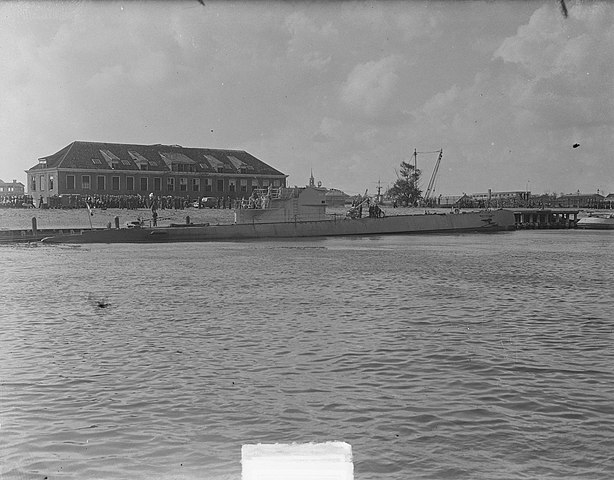
O 27 (ex UD1, ex-O 27) in Den Helder, 1949. Note the rebuilt conning tower to German standard.
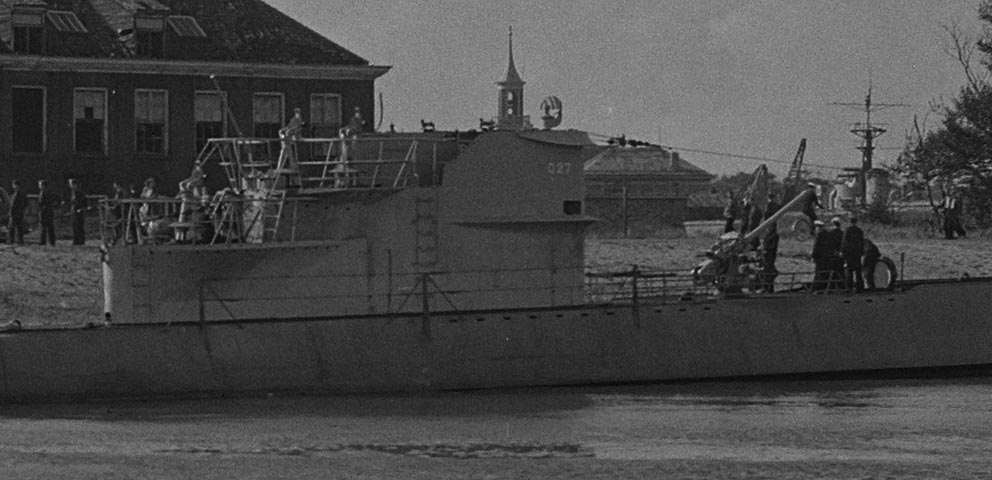
Detail of the rebuilt CT: In German service, she was likely armed with three 20 mm FLAK on her aft platforms, two in tandem on the upper one (the pedestals are still there).
UD5: O 27, last boat of the O 21 class, she shared the same story and was also captured in Rotterdam. During 1941, her diesel system was completely modified, and in November 1941, up to August 1942 she served as a training boat at the 5th training flotilla in Kiel, training her future crew. At last she was actively commissioned on January 30, 1942 and from August 1942 to January 1943 she served with the 10th flotilla in Lorient, preying west of the Cape Verde archipelago. She sank the British cargo SS Primrose Hill (7628 GRT). However from 1943 to May 1945, U-D5 was attached to the U-Abwehrschule in Bergen. In mid-July 1943, U-D5 is said to have been involved in exercises to supply submarines underwater with diesel. During the surrender of May 1945 she was sent in Bergen at Lissahally for Operation Deadlight along with 23 other Uboats. Identified, UD5 went back as O 27 in Dutch service from July 13, 1945, based in Dundee under supervision of the Royal Navy, and later in home water for the Dutch Navy. She served as a test ship for torpedo launches and target ship until 1958 and was sold for BU in December 1960.
British submarines in Dutch service
After May 1940, al Dutch submarines went under allied command, either British ( Europe & south-east asia) or American (Australia). Some served with the British Royal Navy came in addition to those transferred from the Royal Navy, operated by Dutch crews, but still under the frame of the RN. In all four British submersibles were transferred to the Dutch navy in exile (Not the “Free Dutch Navy” it was still called the “Royal Netherlands Navy”, as its assets were still fighting after the fall of the country in 1940 in the far east). After the fall of Java in 1942, what remained of Dutch submarines fled to Australia, Fremantle, operating under US command until the end of the war. The oldest of the K class were of poor value, and were soon decommissioned, the experienced crews transferred to UK to join a new British-built submersible. However, as fortunes of war goes, their transporting liner was sunk in the Atlantic by an U-Boat. This was widly criticized as the ship went unescorted, but all the Dutch submariners colected from three discarded submarines were lost, but a few survivors. The other submarines British-built had untrained crews which were volunteers, young dutchmen which fled the country by sea or other ways. A great deal of time was spend training them on their submarines. Only one, Zwaardvisch, had a truly remarkable career, spent in six theaters of operations, with an enviable hunting board.
These were the:
HrMs Zeehond (ex-Sturgeon), HrMs Zwaardvisch (ex-Talent), HrMs Tijjerhai (ex-Tarn), HrMs Dolfijn (ex-P47). These were all recent models: The first was an old S-class (1931), but the two others were recent, large T class and the P47, one of the unnamed U-class. See the WW2 British submarines section for more.
HNLMS Zeehond:
She was recommissioned on 11 October 1943, under command of Donald Theodoor Mackay. From Portsmouth, she departed for the River Clyde on 11 November 1943 and from 14 November and 10 December, she conducted training off Rothesay and in the Clyde area. On 11 December she left Rothesay for St. John’s, in Newfoundland, encountering heavy seas along her way, which rapidly depleted her fuel for the trip. So she never arrived and was forced back to Londonderry. She made other exercises on River Clyde with HMS Proteus until 8 February 1944, and went to Lerwick for her first war patrol. This was an antisubmarine patrol along the Norwegian coast, uneventful. Zeehond departed again on 18 March for the same mission, and was recalled on 21 March at Lerwick. From 24 March 1944 until the end of the war, she conducted training exercises. Zeehond was Decommissioned on 14 September 1945 in Dundee and returned to Royal Navy, 17 November 1945, to be rapidly sold for BU. She was the only one from the first Group S-class to survive the war.
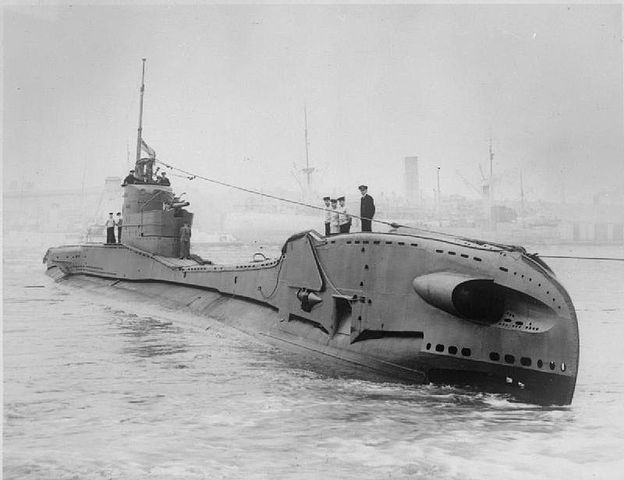
HMS Thorn, of the same model as the Talent/Zwaardvisch
HNLMS Zwaardvisch:
Recommissioned on 23 November 1943 as Zwaardvisch (“Swordfish”) she had a long and distinguished career, first under command of Lt. Hendrikus Goossens. Based in Rothesay she made sea trials in Holy Loch until February 1944. Until March, she undertook patrols in the north Atlantic and off the coast of Norway. She searched for the German battleship Tirpitz. She patrolled on the Portuguese coast in May 1944, and joined Gibraltar, to be later transferred to the Far East. First Trincomalee, Ceylon in July 1944, with the British Far East Fleet, she patrolled the Strait of Malacca, and attacked several Japanese ships, including the Kim Hup Soen and two Malaysian sailing vessels, with her deck gun. She served with the 8th Submarine Flotilla, in Fremantle, Western Australia from September 1944, by then under command of the US fleet. In October 1944 she sank the Japanese guardboat Koei Maru and the Japanese oceanographic research vessel Kaiyō No.2. Buy her best kill was the large minelayer IJN Itsukushima. She also badly damaged the minelayer IJN Wakataka. On 6 October 1944, she sank the German submarine U-168 when patrolling around Java and ordered to ambush her off Surabaya. The U-Boat was on her way to Japan with important military technologies and personal onboard.
Towards the end of the war, she was patrolling the South China Sea and the Lombok Strait. In February 1945, she was attacked by a Japanese aircraft and was back to Fremantle for repairs. She was back in the Java Sea under command of Lt. Jan van Dapperen and went on sinking Japanese merchantmen until May 1945, returning to Fremantle for repairs and fixes when she learned the German surrender and she returned to Britain, Dundee and then Rotterdam in August 1945. She was purchased by the Dutch government and served with the cold war fleet, renamed Zwaardvis in 1950, decommissioned on 11 December 1962.
HNLMS Tijgerhaai (P336)
Although was laid down on 12 June 1943 as HMS Tarn, launched on 29 November 1944, she was never commissioned into the Royal Navy and instead was transferred to the Royal Netherlands Navy. She was recommissioned on 28 March 1945 as Tijgerhaai (“tigershark”), but the war was already drawing to a close, so she spent 1945 undergoing trials. She was purchased by the Dutch government in 1946 and on 19 October 1955, ran aground in Weymouth Bay. She was decommissioned on 11 December 1964.
HNLMS Dolfijn (P47)
Like the Tarn, HMS P47 was transferred to the Royal Netherlands Navy before completion and her career started in September 1942. Until January 1943 she carried out trials with the 3rd Flotilla in Holy Loch. Assigned to the 8th Flotilla in Algiers, until December 1943, and with the the 10th Flotilla in Malta. On her first war patrol she attacked an unidentified U-Boat, missed, but on 9 February 1943, she sank the Italian submarine Malachite (Perla-class) off Cape Spartivento (Sardinia). She snk also the merchant ship Egle, auxiliary patrol vessel V50/Adalia, the sailing vessel Stefano Galleano and four more, plus two German patrol boats. She also damaged the Italian merchanten Humanitas and Sabia and attacked but missed Oria and Leda, for the later, due to the intervention of her escort, TA14. Dolfijn also gun-attacked the barge Vidi, but to broke off the action. From December 1943, and until March 1944, she served with the 1st Flotilla based in Beirut. Refitted at Dundee the war ended, and she became training boat in Amsterdam between 1947 and 1952, decommissioned, returned to the RN but BU in the Netherlands.
Interwar Dutch submarines
In this chapter, we will see separately the colonial boats (later), and those used in home waters, the “O” types. The latter, apart the most earlier WW1 boats, were still active in 1940. Thos who can’t be scuttled and could flee joined the Royal Navy. Depending on their age and capabilities they were given more or less active roles. The most ancient were decommissioned in 1944, and crews transferred on more recent boats.

O9 class Submersibles (1925)

The O 9-class submarines comprised the O 9, O 10 and O 11.
The “O” are coastal and designed to defend the home waters. They have two 530 mm in the bow, two more 450 mm in the bow and one in the stern for merchant vessels, with 10 torpedoes on board.
At the time of the German invasion, O 11 was scuttled while the first two reached UK in roder to continue thier service with the RN, BU in 1945.
O 9 patrolled on 11 May 1940 with O 10 off the coast of the Netherlands, attacked by the luftwaffe. On 12 May 1940 she fled to UK with O 10 and a tugboat, arriving on 15 May 1940. She patrolled in the English Channel and the Bay of Biscay due to her short range, from August 1940 to March 1944, attached to the 7th Training Flotilla based in Rothesay. She was also used as an ASDIC piggy boat and decomm. on 1 December 1944 O 9, stricken in September 1945 and sold.
O 10 also patrolled the English Channel but also the Atlantic Ocean (western approaches) and Bay of Biscay. by the summer of 1940 she was attached to the 7th Training Flotilla in Rothesay, used as an ASDIC piggy boat. Transferred to the 9th Flotilla in Dundee she kept that role from 30 August 1940 to July 1944. She was decomm. on 11 October 1944, stricken in Sepbember 1945 and sold in 1946.
O 11 was accidentally rammed on 6 March 1940 by the tugboat BV 3 in Den Helder. She sank, three man died as a result, buy she was raised and repaired. However she was under repair when Germany invaded the Netherlands and she was scuttled. The Germans raised her but her repairs dragged on and instead she ended in 1945 as a blockship in Den Helder harbor.
Specifications
Displacement: 515/647 tonnes surface/uw
Dimensions: 54.70 x 5.70 x 2.50 m
Propulsion: 2 shaft MAN electric diesels, 900/610 shp. 12/8 knots surf./uw
Crew: 29
Armament: 2 x 530 mm TT, 3 x 450 mm TT, 1 x 88 mm, 1 x 12.7 mm AA MG.
O 12 class (1925):
The O 12-class submarine comprised the O 12-O 15 boats.
O 9 was laid down in the Koninklijke Maatschappij De Schelde in Flushing in 1922. O 10 in Amsterdam at the Nederlandsche Dok en Scheepsbouw Maatschappij in 1923 and O 11 in Rotterdam in 1922 (December) at Fijenoord shipyard, all three were launched in 1925, and completed in January and September 1926. Their interwar service was without notable incident, but they participated in exercizes in the Baltic in 1930-31.
On 9-11 May 1940, O 9 and O 10 were patrolling off the coast of the Netherlands when the first was attacked by the Luftwaffe. Back to base they were informed to flee to UK, and they departed on 12 May 1940 with a tugboat. They made it on 15 May 1940. From then on she would be placed under supervision of the Royal Navy and would patrol the English Channel and the Bay of Biscay. From August 1940 to March 1944 she was part of the 7th Training Flotilla in Rothesay. She was used as an ASDIC piggy boat until decommissioned on 1st December 1944 and stricken in September 1945.
O 10 also reach UK but she was transferred to the 9th Flotilla in Dundee, used from August 1940 to July 1944 and decommissioned on 11 October 1944.
At the time of the German invasion, O 11 was in drydocks for repairs in Den Helder and could not sail, she was scuttled on 14 May 1940 to prevent capture. Nevertheless the occupation forces would later raised the ship and ordered it repaired, but it dragged on until September 1944 and she was sunk to block the entrance.
Specifications
Displacement: 130/150t
Dimensions: 31.1 x 3.1 x 2.9 m (102ft x 10ft 2in x 9ft 6in)
Propulsion: 1 shaft MAN diesel 6-cyl, 1 electric motor 350/200 shp, 11/8.6 knots
Range: 500 nm/10 kts, 26 nm/8.6 kts underwater
Armament: Two 450 mm TTs (17.7 in)
Crew: 10
O 16 (1936):
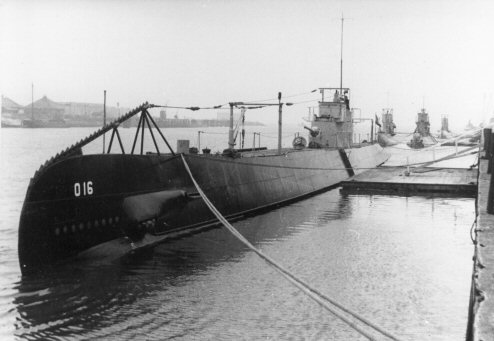
HNLMS O 16 was designed by chief engineer of the Royal Netherlands Navy, G. de Rooij. She was the first he designed as chief engineer of the Royal Netherlands Navy. His predecessor was J.J. van der Struyff. Her design broing out several innovations, due to the high requirements set by the Royal Netherlands Navy. They wanted a larger one, still with high spee, resulting in a 4 metres (13 ft) longer hull, 130 tons more. O 16 was still faster thanks to her powerplant and her hull lines, based on research in the Wageningen basin. The new, finer shape of the hull, forward torpedo tubes set more apart, high quality steel (German grade ‘St52’) use for construction made her also studier, with better tensile strength, elasticity and mechanical properties. She also had a refrigerator and multiple sinks for the crew. It was recoignised as such an international success that the Polish Navy ordered four of this design, resulted in the ORP Orzeł and Sęp, both in addition carrying mine tubes. The latter would be copied in turn by the Netherland Navy with the O 19 class.
Laid down on 28 December 1933 in De Schelde, Vlissingen, launched on 27 January 1936, when she was comm. on 16 October 1936, she was the largest submarine in the Royal Netherlands Navy. She made a shakedown trip to Hamilton, Bermuda and Norfolk, Virginia in 1937 and visited Washington, D.C. in February, hosting the American President Franklin D. Roosevelt. She escorted ships and perform convoy duties, and took part in various execises until 1939. That year she was sent to the Dutch East Indies via the Suez Canal, attached to the submarine division. A Japanese attack was expected as well as attacked from German raiders in the Dutch East Indies. She patrolled the area until November 1941, sent to South China Sea and was based in Singapore. She patrolled the Gulf of Siam and ended under British command withing Submarine division I. She patrolled between Malacca and Siam, and Kota Bharu and Singora, spotting Japanese troopships convoys, attacking but missed. On 12 December 1941, she launched a volley of torpedoes at four different troopships, all hitting, then two more, sinking all four. However, on 15 December 1941 during her homebound voyage to Singapore she hit a Japanese naval mine off Tioman Island, while leaving the Gulf of Siam. 11 out of 42 survived her sinking. Her wreck was rediscovered in 1995 by a Swedish diver.
Specifications
Displacement: 130/150t
Dimensions: 31.1 x 3.1 x 2.9 m (102ft x 10ft 2in x 9ft 6in)
Propulsion: 1 shaft MAN diesel 6-cyl, 1 electric motor 350/200 shp, 11/8.6 knots
Range: 500 nm/10 kts, 26 nm/8.6 kts underwater
Armament: Two 450 mm TTs (17.7 in)
Crew: 10
Class O21 Submersibles (1939)
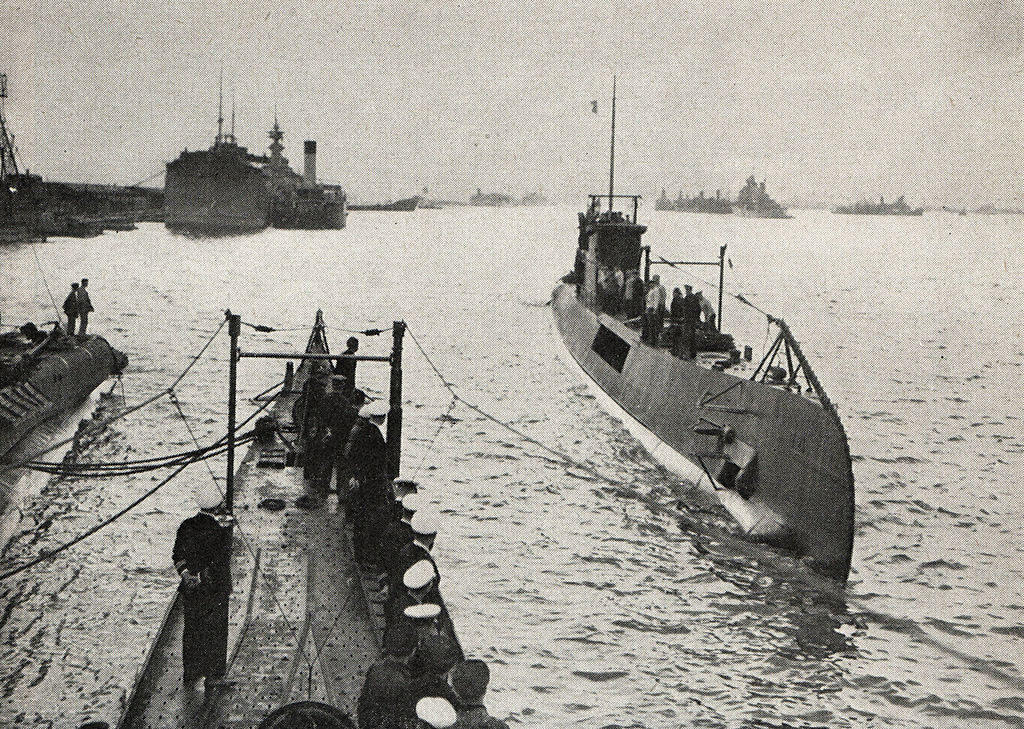
O21 at Gibraltar
Literally modelled on the very successful O19, the O21 were the last Dutch submarines before the Cold War. They were essentially a repeat of O 19 class, but without mine tubes and slightly smaller dimensions. They were diving at 100 meters and had a range of 7,500 nautical miles at 10 knots. The class included 7 units as a result of the mobilization, but only 4 were completed in time, and fled to Britain to avoid capture.
The O 21 class in action
O 21 was laid down on 20 November 1937 as K XXI in Vlissingen, launched on 21 October 1939. Hastily commissioned, she sailed for England on 12 May with O 22 and was completed at the naval yard in Rosyth. She operated off the coast of UK, patrolling the north sea, before being sent to the Mediterranean Sea, and then based in Colombo in the Indian Ocean. Later she operated from Fremantle off the west coast of Australia to rampage in the east indies. She survived the war, decommissioned on 2 November 1957. During her career, she attacked ten ships, sank six, missed one, damaged three: Four Italian, one vichy French, and the rest Japanese, all coasters or merchant.
O 22 was laid down on 20 November 1937 as K XXII at Koninklijke Maatschappij De Schelde, Vlissingen, and launched on 20 January 1940. She was hastily commissioned, sailed for UK on 12 May with O 21 and the tugboat B.V. 37, completed in Rosyth. Integrated into the RN, she operated in the North Sea, making five patrols and during the last, she was lost with her entire crew, including 3 liaison British sailors. Her wreck was discovered in 1993, and the cause of the loss seems is still uncertain. she encountered a German submarine twice during one patrol but was unable to attack her, her torpedoes missing or she was too far away. The wreck discovered by a Norwegian vessel 40 nautical miles southwest of the Norwegian coast by 180 meters deep led to several scenarios to explain her sinking of the O 22. One was she would have sailed adrift German mine. However as her hull looked intact, a technical problems chain seems to be plausible to explain her loss. Conway’s however came with another explanation: She was sunk by the German minesweeper M144, assisted by a patrol boat off Lindense.
O 23 (laid down on 12 October 1937 as K XXIII at Rotterdam), was launched on 5 December 1939. Hastily commissioned and still incomplete, she sailed for England on 13 May to be completed at the Thornycroft shipyard at Southampton. She operated in the North Sea and later the Mediterranean and the Indian Ocean, making twenty war patrols, sank or damaged five ships and survived the war, decommissioned on 1 December 1948.
O 24 was laid down on 12 November 1937 as K XXIV in Rotterdam, launched on 18 March 1940. Hastily commissioned she sailed in UK with O 23 to be completed at the Thornycroft shipyard at Southampton. Attached to the 9th Submarine Flotilla at Dundee in September she patrolled the North Sea and Norwegian coast. In March 1941 she was in the 8th Submarine Flotilla, Gibraltar operating in the Bay of Biscay and Atlantic Ocean. She also took part in convoy patrol duties. Later she sailed for the Mediterranean and operated off the east coast of Italy, sinking several axis ships. In July 1942 she was transferred to the British Eastern Fleet in Colombo, Ceylon. She patrolled the Indian Ocean and the Strait of Malacca, Sumatra, the Andaman Islands. Outside attacks of IJN vessels she also landed small groups British special forces on various islands. By mid-1944 she was refitted at Philadelphia NyD and operated from Freemantle in Australia, patrolling the East Indies. She was in Batavia at V Day, and went home in April 1946, training boat in 1947, decommissioned June 1955, floating battery, and instruction vessel until 1962, struck and sold 1963.
O 25, 26 and 27 were still in construction, and were not scuttled properly in time. They were captured by the Germans and pressed into service in 1941-42, completed to German standards as UD-3, 4 and 5 (see Dutch subs in German service).

Specifications
Displacement: 934t surface, 1350t uw
Dimensions: 78 x 6.50 x 3.80 m
Propulsion: 2 shafts diesels-electric MAN, 5200/1000 hp. 19.5/9 knots surface/uw
Crew: 55
Armament: 8 x 533 mm TTs, 1 x 88 mm, 2 x 40 mm AA, 1 x 12.7 mm MG AA
Submarines for the KNIL
Although the Dutch submarine fleet was never large, and a single one operated in the Dutch east Indies during the war (K 1), the interwar saw far more models built for this station, and in increasing numbers as the Japanese threat was felt real in the 1930s. Submarines built for colonial service were indeed twice as numerous as Dutch home water ones when WW2 broke out. They all participated in operations in the area, first against possible German commerce raiders, and from December 1941, against the IJN fleet and convoys, encountering mixed successed, but managing to sink many military vessels, including destroyers. In all, seven Dutch submarines were lost during the war, from various causes in action.
K I (1913)
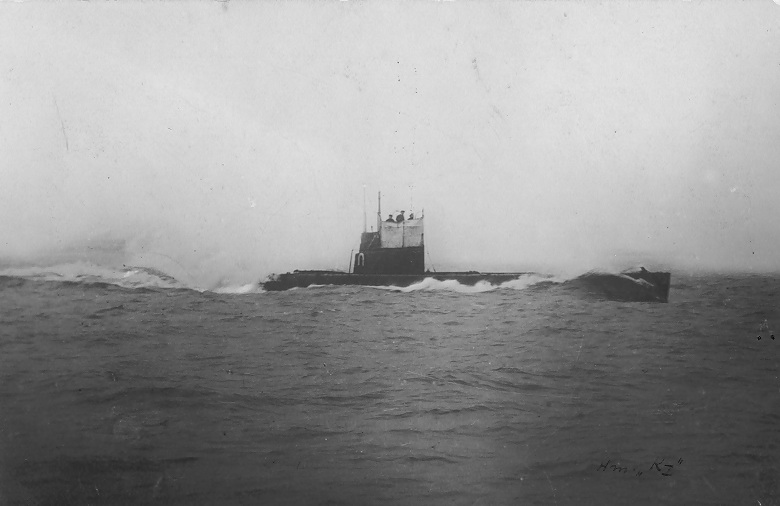
This boat was tailored for colonial service and emphasis was put on a better range, and thus, much larger dimensions and displacement, at 390 tonnes underwater, versus 150 for the O 2 class. Still, it was from the same trusted team, Hay-Whitehead from Fiume. To cope with the tropical heat which could wreck her precious batteries, a tailored cooling system was created on board. During subsequent service, an ingenious crew member connected it to the ventilation system, creating the first air conditioning system in a submarine.
Laid down in 1911 K I was completed and commissioned as the war broke out. However she stayed in home waters until the situation settled, and neutrality secured. She sailed on 12 September 1916 to the Dutch East Indies, towed for most of her trip by the tugboat Witte Zee due to Insufficient range. En route she stopped at the Downs, Vigo, Malta, the Suez Canal, Aden and Colombo, before arriving at Sabang on 6 November 1916. From Sabang there she refuelled, resupplied and headed for Batavia escorted by the coastal defence ship Koningin Regentes. There she stayed in service without notable even, and was decommissioned in 1928.
https://en.wikipedia.org/wiki/O-class_submarine
K II (1919)
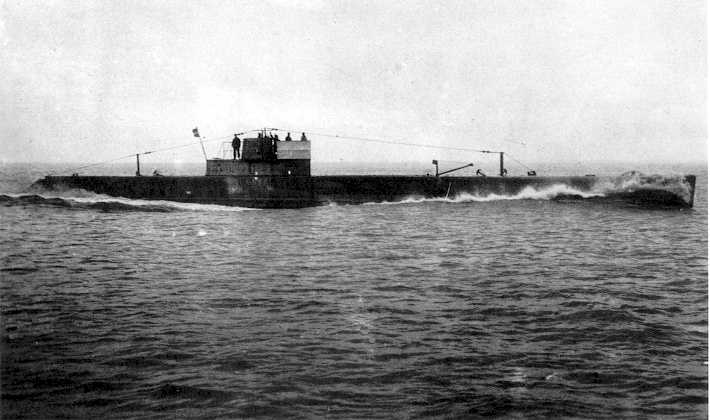
K II was laid down in Rotterdam, Fijenoord yard, on November 20, 1915, launched on February 27, 1919 and commissioned on March 28, 1922, so she missed the great war. In September 1923 she sailed with K VII, K VIII and the tender Pelikaan to the Dutch East Indies, reaching Sabang in December 7, and heading for Tanjung Priok. From 1924 to August 1937 when she was decommissioned, her career was uneventful.
K III-class submarine (1919)
K III, K IV
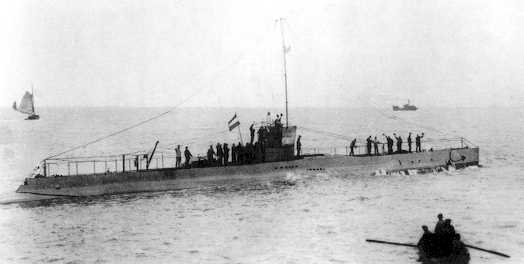
K III: Ordered in 1915, laid down in 15 July in Flushing, De Schelde, she was launched on 12 August 1919 and commissioned on 9 July 1920, departing on 4 September 1920 for the Dutch East Indies, alone, stopping en route in numerous Mediterranean ports and reaching Tanjung Priok on 18 December 1920. Her career was uneventful and she was decommissioned in 1934.
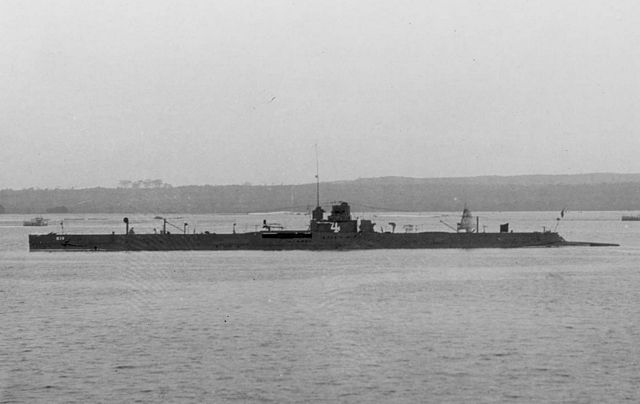
K IV: Launched on 2 July 1920 she was commissioned on 27 April 1921 and departed on 3 September 1921 for the Dutch East Indies, making it in Tanjung Priok on 23 December 1921. While in Colombo, she suffered a battery explosion in her forward compartment, killing 2 and injuring one. She was repaired and resumed her service until decommission in 1936.
K V-class submarine (1919)
K V, K VI, K VII
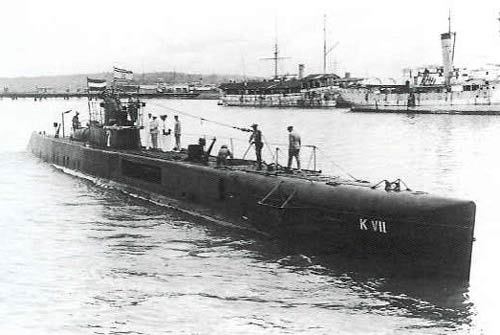
K V: Laid down in Rotterdam at Fijenoord on 4 April 1916, launched on 20 November 1919 she was commissioned on 15 September 1920 and in October 1920 left Den Helder for the Dutch East Indies, arriving on 26 January 1921. She had an uneventful career and was decommissioned on August 1937.
K VI: Laid down in Rotterdam, Fijenoord on 25 July 1916 she was launched on 8 March 1921, commissioned on 5 September 1922. On 18 September 1923 with other subs and the tender Pelikaan she departed for the Dutch East Indies, delayed when Pelikaan ran aground at Tunis. They arrived at Sabang and stayed there until 7 December. They sailed for Tanjung Priok and K VI was still extant in 1941 when Japan attacked the east indies. In Surabaya, in the reserve it was decided in 18 February 1942 to prepare her for departing when she was sank in a Japanese attack in Surabaya harbor.
K VII: K VIII was ordered on 27 June 1917, laid down on 31 October 1917, launched on 28 March 1922 and later commissioned. The war indeed stopped her construction, as many components were supplied by then belligerent nations, UK in particular. On 18 September 1922, K VIII sailed for the Dutch East Indies with her sister ship. In December 1941 she was in reserve in Surabaya. She escape the fat of her sister ship, and in January 1942 patrolled the Java Sea and Madura Strait. After the invasion of Java she fled to Fremantle in Australia. Due to her age, the crew was evacuated to UK to man a more modern boat. She was decommissioned on 18 May 1942, her batteries salvaged to replace those in K IX. She was to be BU in 1943 in Jervoise Bay she sank under tow offshore, abandoned. She was destroyed by explosives in 1957.
K VIII-class submarine (1922)
K VIII, K IX, K X
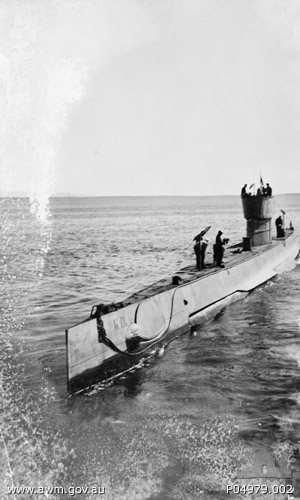
K VIII: K VIII was ordered to Vlissingen on 27 June 1917, laid down on 31 October 1917 and launched on 28 March 1922. She departed in September for the east Indies, a long trop through the Mediterranean and suez canal, reaching Sabang, and Tanjung Priok on 24 December 1922. Her career was uneventful and after in 1939 she was in reserve in Surabaya, but reactivated in December 1941. In January 1942 she patrolled the Java Sea and Madura Strait and fled to Fremantle after the fall of Java. There it was decided due to her age she was of little value and she was decommissioned in May 1942, her crew sent to the UK.
K IX: K IX was in the East Indies by 13 May 1924 and had an uneventful career until the Japanese attack in 1941. By then she was in reserve, but was quickly recommissioned by March 1942. She fled during the fall of Java to Fremantle, reaching the harbour on 13 March 1942. However by May 1942 the Dutch government offered her to the Royal Australian Navy, for ASW training. By June she had been damaged by a torpedo explosion (Attack on Sydney Harbour) and was repaired before recommission as HMAS K9, on 22 June 1943. But she saw little service, often under repair. On 22 January 1944 she suffered an accidental explosion and due to a lack of resources she was decommissioned on 31 March 1944 but still served as an oil lighter. Under tow to be BU, she was washed ashore off Seal Rocks in New South Wales on 8 June 1945 and abandoned. Her wreckage was found in 1999 by the New South Wales Government’s Heritage Office, investigated and blasted.
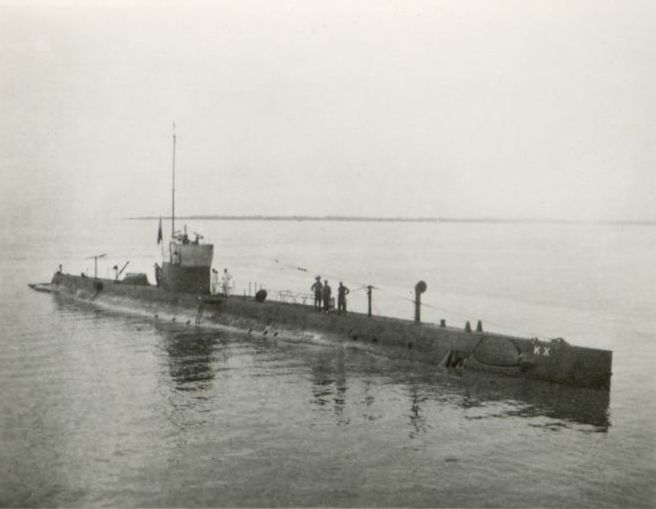
K X: Commissioned on 24 September 1923, she made the trip to the Dutch East Indies alone in late 1924. She was still active in 1939 despite to her age and February-March 1941 together with K VIII and K XIX patrolled the Sunda Strait, from Tanjung Priok. They were on the lookout for the German cruiser Admiral Scheer, signalled in the Indian Ocean. She was in maintenance at Surabaya K X and active again on 8 December 1941. On 25 December 1941 she sailed to the Celebes Sea and on 8 January 1942 arrived at Tarakan (Borneo). There, she was repaired a few days before the Japanese invasion. She left the port on 10 January after dark after spotting one of the invasion ship, and tried to take an attack position when she was spotted by a destroyer and forced to submerge. Due to her mechanical issues she sailed to Surabaya for repairs. She was back on active duty on 24 February, but off Java she was spotted and attacked by depth charges. Badly damaged, she limped back to Surabaya, only to be scuttled on 2 March 1942. Raised by the Japanese she was used by the IJN as a floating oil hulk. She was scrapped in 1946. Her crew (and from two other subamrines) were repatriated in UK to constitute the crew of the Haai (HMS Varne), when their passenger ship, MV Abosso, was sunk by U-575 north of the Azores, on 29 October 1942. Only four of these Dutch submariners survived.
Class K XI Submersibles (1924)
K XI, K XII, K XIII
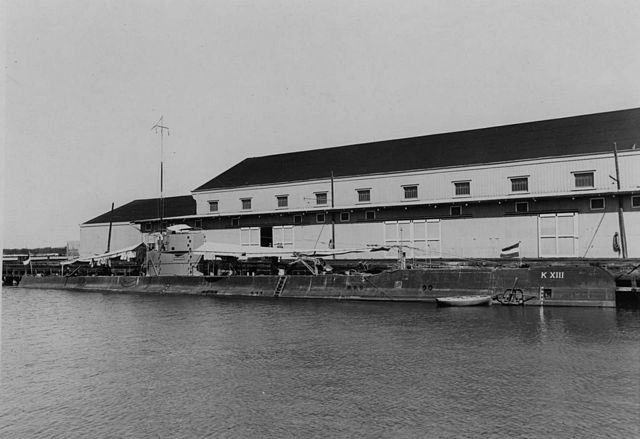
K XIII as completed in 1926
These units were derived directly from the KVIII of 1922. They were larger and better armed, able, thanks to the strengthening of their hull, to dive deeper (60 meters). Like all “K’s”, they were meant to serve in the far Asia squadron. For this purpose, their tubes had a recharge torpedo each, 12 in total, and their trade warfare 450 mm torpedo tubes were distributed front and rear, the 533 were placed in the bow only. Their autonomy of 3500 nautical miles was important. As always, this was a class of three units. KXII was sunk by Japanese planes in the harbor of Soerabaya in February 1942, and the other two managed to take refuge in Australia, carrying out few missions until 1944, when they were disarmed.
KXI: Built by the Fijenoord shipyard at Rotterdam she made a tour to the Baltic Sea with O 8 and Marten Harpertzoon Tromp, Jacob Van Heemskerck, Z3, and Z5. On 15 October 1925, she departed for the Dutch East Indies, embarking in Tunis, Prof. Dr. F.A. Vening Meinesz to conduct gravity measurements. She arrived on 28 December 1925 in Sabang. In May 1940 she was operating off Surabaya, conducting patrols. In early 1941 she joined the 2nd Division Submarine Flotilla, with K X, K XII and K XIII. Until 23 January 1942 she opearted under British operational command and patrolled off Malaya. Until the fall of Dutch East Indies in March 1942 she was in maintenance and fled to Colombo, picking up survivors en route from HMAS Yarra, the depot ship Anking and Parigi after the last naval battle of the sector. In Colombo she was still under British operational command and became a target ship for the RN and the Royal Indian Navy, both for ASW and ASDIC training. She was transferred to Fremantle in Australia on 20 February 1945, only to be decommissioned in early April. She returne din home waters to be disposed of by the Australian Disposal Committee, and scuttled in September 1946.
KXII: Commissioned on 19 May 1925 she departed in September 1926 for the Dutch East Indies. Her career was uneventful, apart her participation on 6 September 1938 to a Royal fleet review at Surabaya. From September 1939 she patrolled the South China Sea and Dutch East Indies water, as south back to Australia. On 7-16 December 1941 she was in the South China Sea as she sank or damaged the Japanese freighter Toro Maru (1,939t) and attack other vessels. Japanese sources however are diverging, giving the name of the troopship Awajisan Maru (9,794t) instead, which seems consistent with the onboard Dutch journal (Unidentified 8,000t ship). on 13 December she sank the Japanese tanker Taizan Maru (3,525t). On 6 March 1942 she fled Surabaya with its naval commander, Pieter Koenraad, and his staff. She arrived in Freemantle, Australia on 20 March and carried out patrols for the Dutch intelligence service, landing spies and commandos on the coast of Java. In June 1943-March 1944 she was under USN command, taiking part in ASW exercises with the RAN, RN and USN off Fremantle. She was paid off in May 1944.
KXIII: Commissioned on 29 March 1926 she departed on 27 May 1926 for the Dutch East Indies, carrying durinh her crossing professor F.A. Vening Meinesz, conducting en route gravity measurements. She visited Horta, Willemstad, Mazatlán, San Francisco, Honolulu, Guam, Yap, Manila, Ambon and Burma, and reach in Surabaya on 13 December 1926. She made other research and operational trips to the Christmas Island, Gulf of Boni, Makassar Strait and Sumatra and in September 1938 participated in the Surabaya Royal fleet review. By december 1941, she was patrolling the South China Sea and Malaya waters. She ambushed, but missed ships of the Japanese invasion fleet on 10 December 1941, on the NE coast of Malaya. When she was in Singapore however, she suffered a severe battery explosion on 21 December 1941. Three were killed, many wounded, but she still could be towed for provisional repairs, and made a surface only trip to Surabaya for main repairs, escorted by the destroyer HrMs Van Nes. She scuttled there to prevent capture on 2 March 1942. This is a diverging record than Conways, which states she fled to Australia and was paid off there in 1944.

Specifications
Displacement: 670/815 tonnes uw
Dimensions: 67 x 6,15 x 3,70 m
Propulsion: 2 shafts diesel-electric MAN, 2400/725 shp. 15/8 kts s/uw
Crew: 31
Armament: 2 x 533 mm TTs, 3 x 450 mm TTs, 1 x 88 mm, 1 x 12.7 mm AA HMG.
classe K XIV Submersibles (1932)
K XIV, XV, XVI, XVII, XVIII
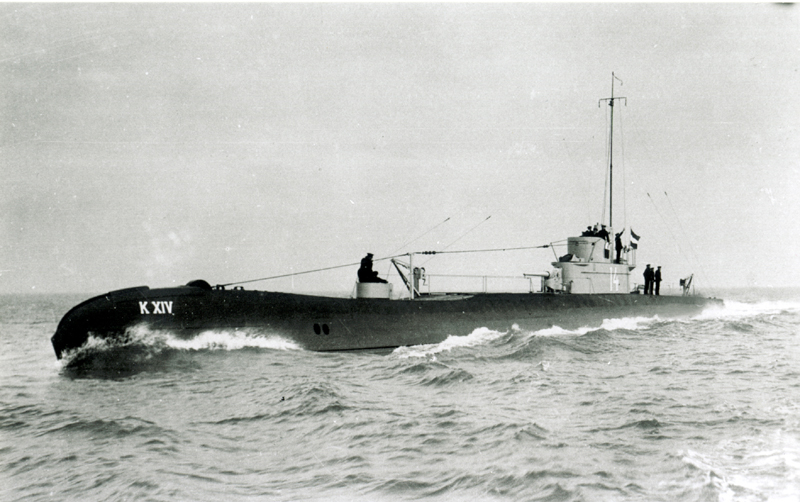
Designed to succeed the K XI of 1924 in the East Indies, this new series included this time 5 units. They were larger, faster and integrated a surface traversible torpedo bank based on the French model. Their eight tubes comprised four in the bow, two in the stern and the two external forward of the conning tower. In total they carried 16 torpedoes. They could dive to 80 meters and had the same autonomy as the K X, of 3500 nautical at 8 knots on the surface.
When Japan attacked, these boats multiplied missions, K XVI managing to torpedo and sink IJN Asagiri on December 24, 1941 to be saunk later by I-66. KXVII and the K XVIII were also sunk, by destroyer gunfire and Deep-charges. The latter survived and managed to join Soerabaya, to be scuttled here. She was refloated by the Japanese and used as a radar picket, then sunk by HMS Taciturn in 1945. K XIV and K XV managed to flee to Australia, and rampaged the east indies until the end of the war.
K XIV: On 7 February 1934 she departed with K XV for the Dutch East Indies, via the Suez Canal. On 6 September 1938 she took part in a naval review in Surabaya in honour of the Dutch Queen Wilhelmina of the Netherlands’s 40th year rule with more than 20 other ships. From December 1941 she multiplied patrols in which she managed to sink or damage a dozen ships: On 23 December 1941, two sunk, three badly damaged. She scored no hits in 1942-44, bud nearly sank the Japanese minelayer IJ Tusgaru in 1944 and sank three Sampans in 1945. She was decommissioned on 23 April 1946, stricked in June 1946.
K XV: On 7 February 1934 she departed for the Dutch East Indies and on 6 September 1938 participated in the same fleet show at Surabaya as her sister.
She was decommissioned on 23 April 1946, and stricken in June. She had little success, but managed on 1 March 1942 to badly damage the IJN Tsurumi, a 8,000 GRT tanker, and sink on 23 April 1944 a sampan or coaster, and a Japanese coastal motor ship the same day.
K XVI: In January 1935, she departed for the Netherlands East Indies. On 24 December 1941, 35 nm (65 km) off Kuching she spotted, torpedoed and sank the Japanese destroyer IJN Sagiri as one torpedo hit her aft magazine, which caught fire and exploded. The same day in the evening she attacked, but missed, the IJN Murakumo and escaped her depth charges. K XVI however eventually was torpedoed by the Japanese submarine I-166, sinking with all hands on 25 December. Her wreck was discovered in 2011 off the northern coast of Borneo.
K XVII: Laid down in Rotterdam, Wilton-Fijenoord Yard on 1 June 1931 she was launched on 26 July 1932 and commissioned on 19 December 1933. She did not left for the Dutch East Indies, however but joined the Baltic squadron, escadre Oostzee, in 1 August 1934. The same squadron comprised the HNLMS Hertog Hendrik, Evertsen, Z 5, and K XVIII. She visited notably Gdynia, Königsberg, Riga and Copenhagen. On 7 January 1935 she departed for the Dutch East Indies, arriving on 26 March 1935 at Padang. On 4 April 1935 she was based in Surabaya, affected to submarine division I. Until 1939 she took part in many exercizes, and when was broken out with Germany she patrolled to prevent any incursion of German or Italian auxiliary cruisers while also monitoring closely Japanese activity since was signed the Tripartite Pact. K XVII also escorted convoys or individual merchant vessels. As the Japanese attacked, her service was short-lived, as when patrolling in the South China Sea, Malaya and exiting the Gulf of Siam on 24 December 1941, she hit a Japanese mine and sank with all hands. Her wreck was located in 1978.
K XVIII: Commissioned on 23 March 1934 and until August 1934 she operatet with K XVIII, K XVII, in the Baltic Sea. She left on 14 November 1934 for the Dutch East Indies, arriving 11 July 1935 in Surabaya after many stops along the way. Felix Andries Vening Meinesz conducted gravity measurements onboard. On 6 September 1938 she took part in the Surabaya naval review. From September 1939 she escorted convoys and patrol the east indies waters. From December 1941, she was not caught in the same area where three of her sister ships were sunk on 23 December. She operated against IJN convoys until the end of the war, sinking two ships and badly damaged one during her short wartime career all three on 23-24. She claimed a destroyer, a freighter and a sub-chaser. On 24 January 1942 she was however depht-charged by Japanese destroyers, and stayed long in Surabaya for repairs, scuttled on 2 March 1942 to prevent capture. Raised and repaired she was converted by the Japanese in 1944 as an air warning picket hulk in the Madura Strait, sunk on 16 June 1945 by HMS Taciturn.

Specifications
Displacement: 771t. surface, 1008t uw
Dimensions: 74 x 7.60 x 3.90 m
Propulsion: 2 shafts diesels-electric MAN, 3200/1000 shp. and 17/9 kts su/uw
Crew: 38
Armament: 8 x 533 mm TT, 1 x 88 mm, 2 x 40 mm AA.
O19 class Submersibles (1938)
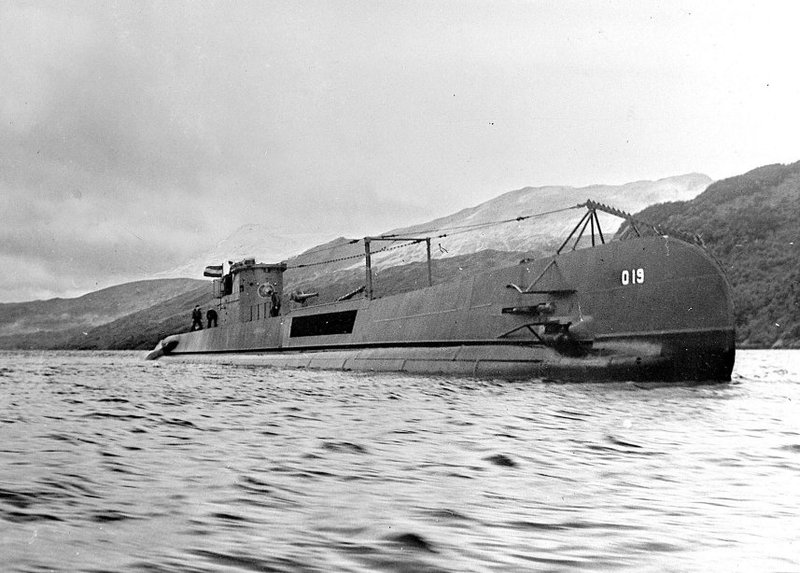
HNLMS O19 in Holy Loch
These two large submarines, just like the O 16 of 1936, these were oceanic models, affected in the East Indies and the first Dutch mine-laying submersibles ever designed. They were very similar to the Orzel and Zep Poles built by the same shipyards, using the patented French Norman-Fenaux system with vertical tubes (20 mines). In particular, they inaugurated a new system for exhausting gases in periscopic dive, which the Germans recovered and perfected as the Snorkel. These large, fast-moving submersibles also used a twin traversable banks of torpedo tubes, four fixed in the bow and two at the stern. The diesel engines were built under license from Sulzer at De Schelde yard in Vlissingen. Her 40 mm Bofors could be stored in watertight compartments on either side of the conning tower, as on O 12-class submarines. The class was also equipped with noise pulses from Atlas Werke in Bremen, at that time best in the world. In 1943 during a maintenance, O 19 noise spanner was replaced by a British Asdic type 120B. They were both sent to the Far East, O 20 being sunk by the destroyer IJN Uranami on December 20, 1941, and O19 ran aground in August 1945 in the China Sea after a busy career.
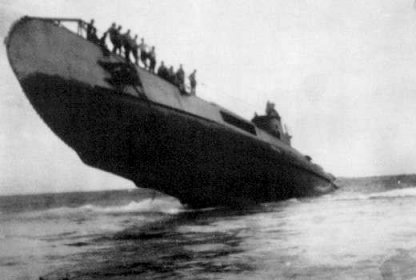
O 19 running aground
O 19: On 10 May 1940, mobilization was proclaimed in the Dutch colony. O 19 was used to protect allied merchant ships and patrol the Indonesian archipelago. On 31 May 1941, she was under command of LTZ 1 F.J.A. Knoops. She made many patrols in the Pacific theater, and from December 1941, attacked IJN communication lines, sinking six Japanese vessels and attacking convoys and laying minefields in strategic locations. On 8 July 1945 she was en route to Subic Bay (Philippines) at 16 knots when she struck Ladd Reef. Unable to pull free of it, her evacuated, and was rescued the USS Cod. To prevent capture she was scuttled using explosives, torpedoes and gunfire.
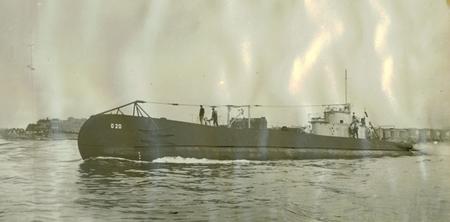
O 20 underway in 1939
O 20: Mobilized in May 1940 she patrolled shipping lanes until 7 December 1941, and she was stationed at the Singapore Submarine Base, under the command of the British Eastern Fleet. On 14 December, she patrolled the South China Sea, sighting two battleships and six IJN cruisers, she gained position with her sister ship to ambush them, splitting paths en route, while 13 transports were spotted off Patani in Thailand and 20 off Kota Bharu in Malaysia. O 20 spotted Japanese destroyers off on 17-19 December and spied two Japanese transports later escorted by the Ayanami, Uranami, and Yugiri. On the 19, she was under attack by a plane, she dove and later attacked by depth charges which destroyed her listening device. She survived a half-hour hammering, and escaped full speed ahead, all planes rising, but became mired in the mud. Air was blown, which alerted the destroyers. But she was able to emerge at night and escaped at full speed. However she filled at the screw shafts. Hatch was opened when surfaced, her pipes began to spark, until the commander decided to shut them, but she was spotted by IJN Uranami using her searchlight. The latter opened fire, missed, while O 20 machine guns was manned, and she manoeuvered to fire her torpedoes. Until she was, she took a fourth volley in conning tower and main hull. She returned fire with her 40 mm AA gun, and fired her port side torpedo but missed. Badly damaged, the captain ordered all hands on deck. She was scuttled by flooding all main ballast tanks. The destroyer followed the sub, cutting through the crew at 20 knots (37 km/h) while dropped depth charges. Uranami would rescue 32 survivors, and her captain had behave humanly, dropping her remaining depth charges throughout the remainder of the night to keep sharks away. They will end as POWs. Her wreck was rediscovered in 2002.

Specifications
Displacement: 9981t/1536t uw
Dimensions: 81 x 7.50 x 4 m
Propulsion 2 shafts diesels-electric MAN, 5200/1000 cv. 19.25/9 kts uw
Crew: 55
Armament: 8 x 530 mm, 1 x 88 mm, 2 x 40 mm AA, 40 mines.
Read more/Src
https://en.wikipedia.org/wiki/List_of_submarines_of_the_Netherlands
http://ahoy.tk-jk.net/macslog/DutchSubmarinesinWorldWar.html
http://www.hisutton.com/Dutch_WW2_Subs.html
https://archive.is/20130624210459/http://www.dutchsubmarines.com/classes/class_ki.htm
http://www.dutchsubmarines.com/
https://www.maritimemysteries.org/k-xvi.html
https://en.wikipedia.org/wiki/K_XIV-class_submarine
http://ahoy.tk-jk.net/macslog/DutchSubmarinesinWorldWar.html
https://www.tracesofwar.nl/articles/2233/Onderzeeboten-van-de-O-19-klasse.htm?c=gw
https://scholarlypublications.universiteitleiden.nl/handle/1887/16629
About the K12 (Daily Telegraph)
Complete war records of K 12
Conway’s all the world’s fighting ships 1906-1921 and 1922-47
Fontenoy, Paul E. (2007). Submarines: An Illustrated History of Their Impact (Weapons and Warfare).
Jalhay, P.C.; Wijn, J.J.A. (1997). Ik nader ongezien! De onderzeeboten van de Koninklijke Marine. Amsterdam: De Bataafsche Leeuw.
Hi Sutton – Advanced Dutch multi-hull submarine designs of World War Two


 Latest Facebook Entry -
Latest Facebook Entry -  X(Tweeter) Naval Encyclopedia's deck archive
X(Tweeter) Naval Encyclopedia's deck archive Instagram (@navalencyc)
Instagram (@navalencyc)





 French Navy
French Navy Royal Navy
Royal Navy Russian Navy
Russian Navy Armada Espanola
Armada Espanola Austrian Navy
Austrian Navy K.u.K. Kriegsmarine
K.u.K. Kriegsmarine Dansk Marine
Dansk Marine Nautiko Hellenon
Nautiko Hellenon Koninklije Marine 1870
Koninklije Marine 1870 Marinha do Brasil
Marinha do Brasil Osmanlı Donanması
Osmanlı Donanması Marina Do Peru
Marina Do Peru Marinha do Portugal
Marinha do Portugal Regia Marina 1870
Regia Marina 1870 Nihhon Kaigun 1870
Nihhon Kaigun 1870 Preußische Marine 1870
Preußische Marine 1870 Russkiy Flot 1870
Russkiy Flot 1870 Svenska marinen
Svenska marinen Søværnet
Søværnet Union Navy
Union Navy Confederate Navy
Confederate Navy Armada de Argentina
Armada de Argentina Imperial Chinese Navy
Imperial Chinese Navy Marinha do Portugal
Marinha do Portugal Mexico
Mexico Kaiserliche Marine
Kaiserliche Marine 1898 US Navy
1898 US Navy Sovietskiy Flot
Sovietskiy Flot Royal Canadian Navy
Royal Canadian Navy Royal Australian Navy
Royal Australian Navy RNZN Fleet
RNZN Fleet Chinese Navy 1937
Chinese Navy 1937 Kriegsmarine
Kriegsmarine Chilean Navy
Chilean Navy Danish Navy
Danish Navy Finnish Navy
Finnish Navy Hellenic Navy
Hellenic Navy Polish Navy
Polish Navy Romanian Navy
Romanian Navy Turkish Navy
Turkish Navy Royal Yugoslav Navy
Royal Yugoslav Navy Royal Thai Navy
Royal Thai Navy Minor Navies
Minor Navies Albania
Albania Austria
Austria Belgium
Belgium Columbia
Columbia Costa Rica
Costa Rica Cuba
Cuba Czechoslovakia
Czechoslovakia Dominican Republic
Dominican Republic Haiti
Haiti Hungary
Hungary Honduras
Honduras Estonia
Estonia Iceland
Iceland Eire
Eire Equador
Equador Iran
Iran Iraq
Iraq Latvia
Latvia Liberia
Liberia Lithuania
Lithuania Mandchukuo
Mandchukuo Morocco
Morocco Nicaragua
Nicaragua Persia
Persia San Salvador
San Salvador Sarawak
Sarawak Uruguay
Uruguay Venezuela
Venezuela Zanzibar
Zanzibar Warsaw Pact Navies
Warsaw Pact Navies Bulgaria
Bulgaria Hungary
Hungary

 Bundesmarine
Bundesmarine Dutch Navy
Dutch Navy Hellenic Navy
Hellenic Navy Marina Militare
Marina Militare Yugoslav Navy
Yugoslav Navy Chinese Navy
Chinese Navy Indian Navy
Indian Navy Indonesian Navy
Indonesian Navy JMSDF
JMSDF North Korean Navy
North Korean Navy Pakistani Navy
Pakistani Navy Philippines Navy
Philippines Navy ROKN
ROKN Rep. of Singapore Navy
Rep. of Singapore Navy Taiwanese Navy
Taiwanese Navy IDF Navy
IDF Navy Saudi Navy
Saudi Navy Royal New Zealand Navy
Royal New Zealand Navy Egyptian Navy
Egyptian Navy South African Navy
South African Navy






























 Ukrainian Navy
Ukrainian Navy dbodesign
dbodesign
28 Nov 1941 at 0:50: O 21 sinks (torpedo attack) the German submarine U 95 (769t). Several survivors are taken on board, but 35 men are lost. Position: 36°24’N-03°20’W, southwest of Almeria, Spain. The survivors are taken to Gibraltar.
Some notes from ‘U-boats Destroyed’ by Paul Kemp: U 95, under the command of KapitanLeutnant Gerd Schreiber, was sunk in a torpedo attack by the Dutch O 21, which was returning to Gibraltar from an uneventful patrol off Naples. At 0030 on 28 November, in clear weather and bright moonlight, U 95 sighted the Dutch submarine first but was reluctant to attack since Schreiber knew that other German boats were in the area. Instead he challenged her using the signal code then in force. The Dutch CO was operating with no such inhibitions. Directly the German challenge was made. The Dutch fired one torpedo at 2,000 yds which missed; a second was fired at the U-boat, which saw it coming but, while turning to starboard to comb the attack, ram right into it Casualties 33. Survivors: 4off, 3 senior rates, 5 junior rates.
The above is from the website http://www.dutchsubmarines.com there is everything to find about the Dutch submarines.
Thanks for the precision !
The site was listed in the sources, a great help indeed.
Best.